IFA 2016: Examining the Malaise of Bargain Basement Virtual Reality
by Dr. Ian Cutress on September 9, 2016 9:00 AM ESTBargain Basement, 1 + 2 + 3
#1: Feihong Industry Company Limited and the FXH-09
The first AIO-VR (all-in-one virtual reality HMD) was actually one of the better ones out of the set. For $100 sample price, coming down to $75 on 3000+ orders, the headset uses a Rockchip RK3288 SoC which we’ve seen in tablets before. It’s a four-core ARM Cortex-A17 design, running at up to 1.8 GHz, with Mali T760MP4 graphics. It barely powers a tablet, so you can imagine it does wonders in an AIO-VR.
Aside from the SoC, the headset uses a single 5-inch IPS Full-HD display, similar to a smartphone unit. The display actually quotes 72% NTSC, with 60 Hz and 1000:1 contrast ratio (I should be so lucky). The 2GB/16GB arrangement is on the low end, and to my surprise (or perhaps not) there is only 802.11n in this model, and I would bet that it is single stream as well. Battery comes in at 4000 mAh.
Other specifications include a mini-HDMI port, micro-USB for charging, 5V/2A charging supported, a bundled Bluetooth joypad, and a total device weight of 460g. It’s worth noting that this headset, like a number of others in this list, uses a modified version of Android. The Nibiru variant seems designed for VR interaction in this case.
The design is simple, as one might expect from an ODM (it’s up to the OEM/reseller to add the flair), and this headset goes above a number of others in this list – we have separate controls for IPD (inter-pupillary distance, as in the distance between the eyes because everyone is different) as well as screen positioning for eye-lens-screen focusing. The lenses move as one unit for IPD adjustments, in and out, but that is more than most.
There’s no counterweight on the rear, meaning that the whole 460 grams rests on the face, and the design uses the side pad for in-scene adjustments. The nose grip at the bottom certainly wasn’t complete, letting in light; however I was told that again it can be an OEM adjustment.
If it’s $75 for the OEM, by the time it hits the market it would be at least double that, once a few stickers, logos and distribution is added.
#2: rftech VRA009
If you have ever wanted to look like Geordie LaForge from Star Trek, the rftech might have something cheap enough for a bad costume. The VRA009 is their ODM solution, striking at the heart of the low cost.
It’s all in the specifications: an Allwinner F1C100A, which is a single ARM9-based 32-bit core ARM926EJ-S solution with an integrated VPU in the back end, but the dual 800x480 screens might be the catch. Fair play in actually using dual 3-inch Sharp LCD panels giving a total 800x960 resolution, but I wonder which would struggle the most: understanding the low pixel environment or the low-end GPU stretched to the limit.
The marketing image on the side showed a picture of the Hulk in the field of view, and quoted 3D play time of 4 hours, with an integrated ‘real 3D player’. I wonder if that’s 3D in the sense of pseudo applied 3D, or actual 3D content - but not the 120 Hz stuff as I’m pretty sure these are 30/60 Hz panels. Other specifications were not present, I was told I’d be sent a press kit but none arrived at the time of posting.
The black on blue visor look draws the eye to the design, and the AIO-VR puts all the buttons on the bottom. We get a full directional pad, a power/return button, a micro-USB for charging, and a slider indicating ‘2D/3D1/3D2’, which I can only assume is a slight adjustment for the lenses depending on the mode it is in. There is no IPD adjustment, with the lenses being fixed.
The inside of the VRA009 was also bathed in light when equipped (hunting for VR at these shows is like an RPG), with the leatherette surround instantly feeling uncomfortable and obviously prone to inducing sweat over long periods.
In this case, I’m sure that rftech is pitching this device purely for media content consumption. I doubt it could pass even basic 3D interactivity without inducing nausea, but that’s something that you have to play with when it comes to cheaper VR headsets.
#3: OMG Electronic Limited
No name for this particular AIO-VR, and no specs either, but it does a new thing that the other headsets haven’t done so far – per-eye IPD adjustments.
The styling is a basic black surround over a white chassis, which seems to be a common theme with these headsets. There’s space for the OEM/reseller to slap a logo on the front, and all the buttons are placed at the top.
Dual directional pads cater for practically everything in a very simple ‘here are some Android buttons and a d-pad’ implementation. The power button is extremely close to the volume down button, so I can imagine a user quite easily fumbling for it and accidentally turning the hardware off. Oops.
The bottom has the IPD adjustment sliders, and they were actually very smooth in their operation. When in position, tilting the headset did not adjust the arrangement, which is good to see (and something I might fear from a cheap headset). The bottom of the device also has a USB port, a microSD card slot, a 3.5mm jack for audio and what I believe is a mini-HDMI port as well.
Inside, the lenses look substantial bits of PMMA (polymethylmethacrylate) plastic, as there would be no glass here, with a woven spongy surround that feels a lot better than the leatherette of other devices. Again, there’s no real nose guard for stray light, leaving it up to the reseller to sort out.




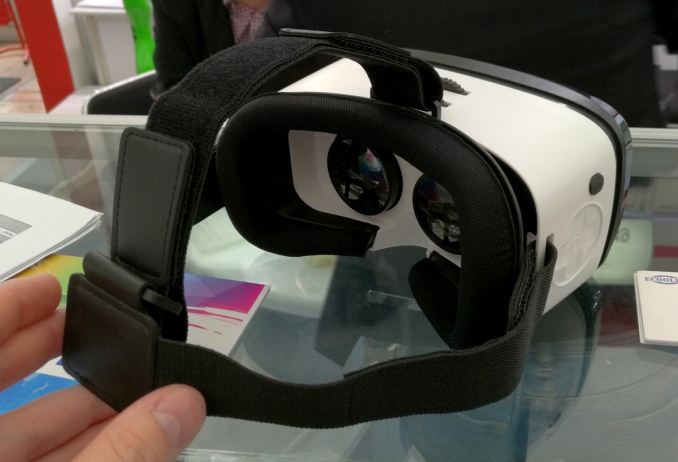









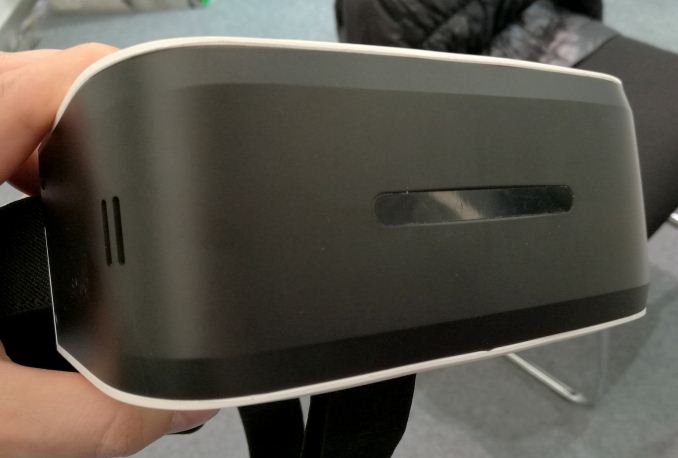
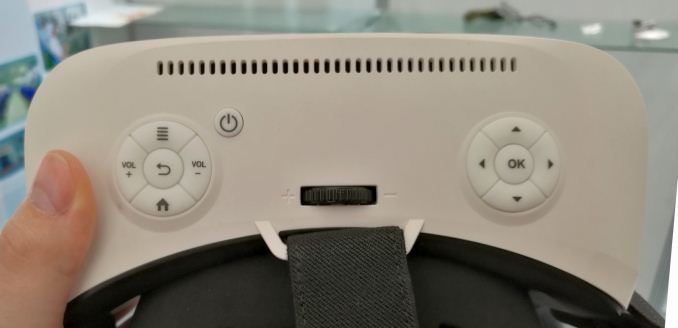
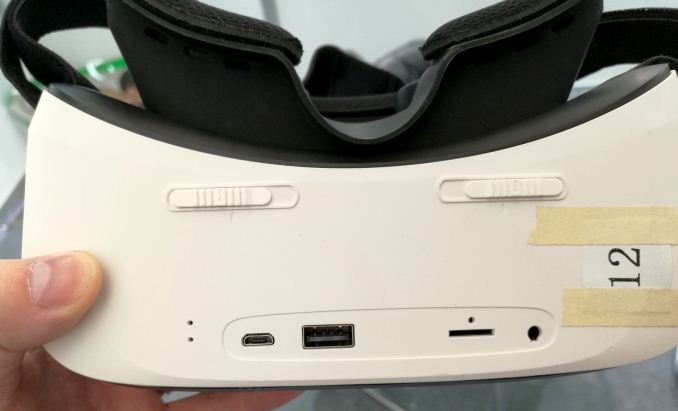
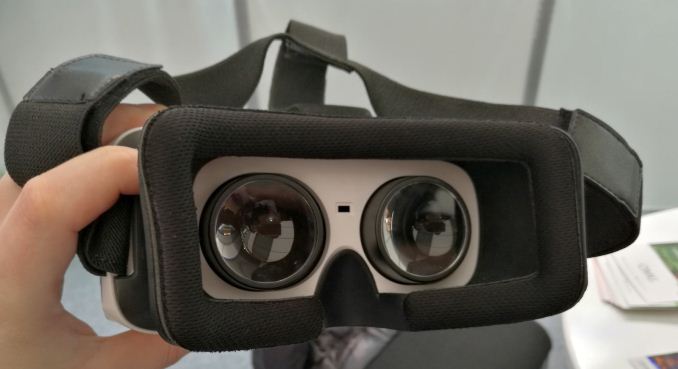








59 Comments
View All Comments
Mugur - Monday, September 12, 2016 - link
IFA 2016? It's in the title...rahulsolanki1818 - Monday, September 12, 2016 - link
virtual reality is an awesome technology , it has improved the way of watching videos.Shadowmaster625 - Monday, September 12, 2016 - link
2.7 million by the end of 2017? At that rate it is going to be 5 years before we see a true killer app for VR. It is going to take a Nintendo-level innovation to actually speed this up.StrangerGuy - Tuesday, September 13, 2016 - link
Given how absolutely tiny the VR market is, I will go as far as to say any VR solution without a first party killer app will be an automatic market failure (like the writeup mentioned, good luck with the chicken and egg problem as a pure HW or SW VR vendor). That only leaves the current gen consoles and Apple with any chance of mainstream success at VR.Nenad - Monday, September 12, 2016 - link
I have GearVR, and I can see advantages of why this can be better than Samsung GearVR - and it is not the price. Basically, this would be "always ready" for use, unlike GearVR where you need to unlock, dock, then undock and unlock again (common GearVR bug that asks to 'unlock' already unlocked phone), then optionally clean phone display etc...
Often I had idea to use GearVR for some short gaming or 3D movie, and decided against due to this 'preparation' time. It is same reason as why I never used my PC for movie watching on TV, even if streaming works - too much time in preparations (set secondary display, change TV source...). It is amazing how important it is for things to "just work" with push of a button, without any complex preparation needed, if people are to use that thing frequently.
mebalzer - Monday, September 12, 2016 - link
As some who develops both hardware and software for VR and Mixed Reality, I appreciate great articles like this to confirm my own findings. Frankly buy a one of the Chinese Snapdragon 820/821 phones from LeTV, OnePlus3. Xiaomi, ZTE, or ZUK or the new Nexus/Pixel that will be Google Daydream compatible with an HMD shell and call it a day. Trying to push more than 60 fps on a mobile platform is hard if you want more than simple shaders and geometry and frankly anymore than that strapped to your head makes no sense. I would rather see more HMD designs like the Pico NEO which tethers the processor/battery/control and keeps the headset light.I can't say a lot right now, but a dual component design that I feel will afford you the ability to use a more powerful SOC (one we haven't seen in a phone), improved (light and comfortable) HMD design, display panel and optics, IMU, positional tracking and a power source without making the thing look the monstrosities from from Intel & AMD is really the only the course one can go at this time if you want to compete with the HTC Vive or even the Sony Playstation VR.
Sadly, getting it to a price point that doesn't make someone have second thoughts that they should have went with a dedicated system is the real challenge and frankly we are not there yet.
By the way, a little sneak peek at my NEODiVR uPLAy http://neodivr.com/images/NEODiVR-uPLAy-280.gif
cptnjarhead - Thursday, September 15, 2016 - link
I have the G7 edge with gearVR. I absolutely love it! Oculus store is great, and the content grows all the time. One of the best apps is the Netflix app. End space (not a rail shooter) is a really fun game, coupled with a Bluetooth controller you really get a great space flight experience. Affected the manor, well my daughter watches scary movies all the time without flinching, and she only lasted 2 minutes with affected, she threw the whole headset off. Sure the graphics are not Vive, or rift, but the whole system works like a console. easy menus and setup. Thats why i feel sony will have the best VR for the money. Content, cost and ease of use will be the winner. If successful, that will push more development to PC and other platforms and in a few years, the current high end VR platforms will seem archaic.serendip - Thursday, September 22, 2016 - link
I just got a VR Box unit as seen in the first image. It's like a fancier Google Cardboard device, with two lenses and a smartphone holder. Surprisingly it's not bad, I use it with a Xiaomi Redmi Note 3 and the resolution is decent. My favorite app so far is a solar system flythrough - the planets look huge hanging in 3D space, although the phone gets burning hot after 10 minutes of play. Movies don't look good on this because the pixels are visible.kompanions - Friday, May 1, 2020 - link
Virtual Reality is one of the trending buzzwords of the last couple of years, and yet many people say it still has a way to go until it "catches".